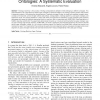DLOG
2010
13 years 10 months ago
2010
Abstract. A usage scenario of bio-ontologies is hypothesis testing, such as finding relationships or new subconcepts in the data linked to the ontology. Whilst validating the hypot...
DLOG
2010
13 years 10 months ago
2010
Abstract. Inconsistency and incoherency are two sorts of erroneous information in a DL ontology which have been widely discussed in ontology-based applications. For example, they h...
TKDE
2010
13 years 10 months ago
2010
—“Ontology matching” is the process of finding correspondences between entities belonging to different ontologies. This paper describes a set of algorithms that exploit uppe...
SUM
2010
Springer
13 years 10 months ago
2010
Springer
Most of the frequently used ontology mapping methods to date are based on linguistic information implied in ontologies. However, same concepts in different ontologies can represen...
SPRINGSIM
2010
13 years 10 months ago
2010
—Data Fusion (DF) process is in the interest of the military community since it provides the opportunity to achieve information superiority. The System Entity Structure (SES) is ...
OIR
2010
13 years 10 months ago
2010
Purpose – The purpose of this paper is to examine the integration of digital library (DL) technologies with ontology-based knowledge representation in providing semantic rich in...
JUCS
2010
13 years 10 months ago
2010
: Ontologies are used to represent a variety of domain knowledge and data collections, scopes, viewpoints and linked heterogeneous information sources. They range from simple topol...
IJMSO
2010
13 years 10 months ago
2010
: Development and use of ontologies is increasing, but hampered by new challenges, such as determining which ontologies to reuse and which language to use. Ontology development met...
IDT
2010
13 years 10 months ago
2010
A person adds new knowledge to his/her mind, taking into account new information, additional details, better precision, synonyms, homonyms, redundancies, apparent contradictions, a...
ER
2010
Springer
13 years 10 months ago
2010
Springer
: Data provenance is becoming increasingly important for biosciences with the advent of large-scale collaborative environments such as the iPlant collaborative, where scientists co...




